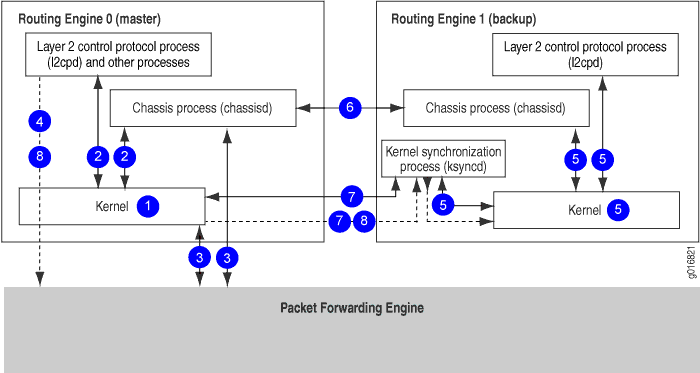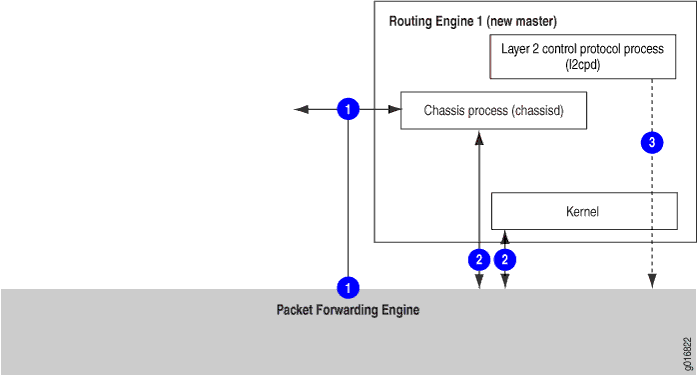Understanding Nonstop Bridging
Nonstop bridging (NSB) helps preserve interface and kernel information on Routing Engine switchover, and synchronizes all protocol information for NSB-supported Layer 2 protocols between the primary and backup Routing Engines.
Nonstop Bridging Concepts
Nonstop bridging uses the same infrastructure as graceful Routing Engine switchover (GRES) to preserve interface and kernel information. However, nonstop bridging also saves Layer 2 Control Protocol (L2CP) information by running the Layer 2 Control Protocol process (l2cpd) on the backup Routing Engine.
To use nonstop bridging, you must first enable graceful Routing Engine switchover on your routing (or switching) platform. For more information about graceful Routing Engine switchover, see Understanding Graceful Routing Engine Switchover.
Figure 1 shows the system architecture of nonstop bridging and the process a routing (or switching) platform follows to prepare for a switchover.

The switchover preparation process for nonstop bridging follows these steps:
-
The primary Routing Engine starts.
-
The routing platform processes on the primary Routing Engine (such as the chassis process [chassisd] and the Layer 2 Control Protocol process [l2cpd]) start.
-
The Packet Forwarding Engine starts and connects to the primary Routing Engine.
-
All state information is updated in the system.
-
The backup Routing Engine starts, including the chassis process (chassisd) and the Layer 2 Control Protocol process (l2cpd).
-
The system determines whether graceful Routing Engine switchover and nonstop bridging have been enabled.
-
The kernel synchronization process (ksyncd) synchronizes the backup Routing Engine with the primary Routing Engine.
-
For supported protocols, state information is updated directly between the l2cpds on the primary and backup Routing Engines.
Figure 2 shows the effects of a switchover on the routing platform.

The switchover process follows these steps:
-
When keepalives from the primary Routing Engine are lost, the system switches over gracefully to the backup Routing Engine.
-
The Packet Forwarding Engine connects to the backup Routing Engine, which becomes the new primary. Because the Layer 2 Control Protocol process (l2cpd) and chassis process (chassisd) are already running, these processes do not need to restart.
-
State information learned from the point of the switchover is updated in the system. Forwarding and bridging are continued during the switchover, resulting in minimal packet loss.
Understanding Nonstop Bridging on EX Series Switches
You can configure nonstop bridging (NSB) to provide resilience for Layer 2 protocol sessions on a Juniper Networks EX Series Ethernet Switch or on an EX Series Virtual Chassis with redundant Routing Engines.
NSB operates by synchronizing all protocol information for NSB-supported Layer 2 protocols between the primary and backup Routing Engines. If the switch has a Routing Engine switchover, the NSB-supported Layer 2 protocol sessions remain active because all session information is already synchronized to the backup Routing Engine. Traffic disruption for the NSB-supported Layer 2 protocol is minimal or nonexistent as a result of the switchover. The Routing Engine switchover is transparent to neighbor devices, which do not detect any changes related to the NSB-supported Layer 2 protocol sessions on the switch.
For a list of the EX Series switches and Layer 2 protocols that support NSB, see EX Series Switch Software Features Overview and EX Series Virtual Chassis Software Features Overview.
Nonstop bridging provides a transparent switchover mechanism only for Layer 2 protocol sessions. Nonstop active routing (NSR) provides a similar mechanism for Layer 3 protocol sessions.
Nonstop Bridging System Requirements
This topic contains the following sections:
Platform Support
Nonstop bridging is supported on MX Series 5G Universal Routing Platforms. Your system must be running Junos OS Release 8.4 or later.
Nonstop bridging is supported on EX Series switches with redundant Routing Engines in a Virtual Chassis or in a Virtual Chassis Fabric.
Nonstop bridging is supported on QFX Series switches in a Virtual Chassis or in a Virtual Chassis Fabric.
For a list of the EX Series switches and Layer 2 protocols that support nonstop bridging, see EX Series Switch Software Features Overview.
All Routing Engines configured for nonstop bridging must be running the same Junos OS release.
Protocol Support
Nonstop bridging is supported for the following Layer 2 control protocols:
Spanning Tree Protocol (STP)
Rapid Spanning Tree Protocol (RSTP)
Multiple Spanning Tree Protocol (MSTP)
VLAN Spanning Tree Protocol (VSTP)
